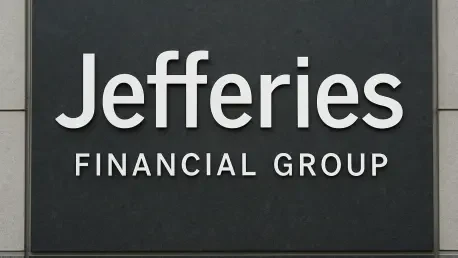In the intricate world of financial markets, few dynamics are as compelling as the overwhelming influence of institutional investors on companies like Jefferies Financial Group Inc. (NYSE:JEF), a powerhouse in the financial services sector. With a staggering 69% of its shares held by institutions, the company stands as a prime example of how large asset managers and pension funds can shape corporate strategy and market performance. This significant ownership not only underscores the confidence that professional investors place in the firm but also raises questions about the potential risks tied to such concentrated power. As market capitalization recently surged by $530 million in a single week, the stakes for shareholders have never been higher. This article delves into the mechanisms of institutional dominance at Jefferies, exploring the implications of their substantial holdings, the role of insider ownership, and the delicate balance of opportunity and volatility that defines the company’s current standing in the financial landscape.
Unpacking the Power of Institutional Ownership
The sheer scale of institutional ownership at Jefferies Financial Group, pegged at 69%, highlights a critical reality: these investors hold the reins when it comes to influencing stock price movements and corporate decisions. Major players, including asset management giants like BlackRock, Inc., which owns a 7.7% stake, form a concentrated power base, with the top 10 shareholders collectively controlling 51% of the company. This level of control suggests that their coordinated actions could sway boardroom strategies and market sentiment in profound ways. Beyond mere numbers, this dominance lends a layer of credibility to the firm, as institutions often align their portfolios with companies showing consistent growth and stability. Their investment decisions are typically grounded in rigorous analysis, benchmarking performance against major indices, which signals to the broader market that Jefferies is a worthy contender. However, this concentration also introduces a vulnerability—should these key stakeholders decide to offload their holdings simultaneously, the resulting sell-off could precipitate sharp declines in stock value, unsettling smaller investors.
Equally important is the broader implication of such institutional sway on market dynamics surrounding Jefferies Financial Group. While their presence often stabilizes a company’s reputation among professional circles, it also means that the stock’s sensitivity to institutional trading actions is heightened. Unlike firms with more dispersed ownership or significant hedge fund involvement, Jefferies lacks activist investor pressure, which can sometimes drive rapid strategic shifts. Instead, the focus remains on long-term institutional strategies, which can either bolster confidence or amplify volatility depending on market conditions. For shareholders, this creates a double-edged scenario where the potential for steady gains is counterbalanced by the risk of sudden price swings if major players adjust their positions. The recent $530 million boost in market capitalization exemplifies how institutional backing can fuel positive momentum, yet it also serves as a reminder that their influence is a dominant force shaping the company’s financial narrative, demanding close attention from all market participants.
The Role of Insider Commitment in the Ownership Mix
Beyond institutional dominance, insider ownership at Jefferies Financial Group plays a pivotal role in reinforcing trust among investors, with 20% of shares held by key company figures. Prominent among them are Joseph Steinberg, a top executive with a 10% stake, and CEO Richard Handler, who owns 8.0% of the firm. This substantial personal investment by insiders signals a strong alignment between management’s interests and the long-term success of the company. When executives have significant skin in the game, it often translates to decisions that prioritize sustainable growth over short-term gains, a factor that institutional investors likely view favorably. This synergy between insiders and institutions creates a robust framework of accountability, as both parties are incentivized to steer the company toward profitability. For external shareholders, this insider commitment offers reassurance that leadership is deeply invested in navigating market challenges, enhancing the overall perception of stability within the firm’s governance structure.
Complementing this insider influence is the positive impact on recent performance metrics, which have benefited both institutional and individual shareholders. The one-year return of 8.5% for Jefferies Financial Group reflects growing confidence in its strategic direction, a trend that insiders have undoubtedly contributed to through their vested interest. Their substantial holdings mean that any upward trajectory in stock value directly bolsters their personal wealth, further aligning their goals with those of other investors. However, while this insider stake mitigates some risks associated with institutional dominance, it does not eliminate the overarching concern of market volatility driven by larger shareholders. The interplay between these two ownership groups creates a unique dynamic where insider confidence can act as a stabilizing force, yet the sheer weight of institutional power remains the primary driver of market behavior. This balance is crucial for understanding how Jefferies navigates its current financial landscape, blending internal commitment with external influence.
Navigating the Risks and Rewards of Concentrated Power
Reflecting on the ownership structure of Jefferies Financial Group, it becomes evident that the 69% institutional stake, coupled with a 20% insider holding, has crafted a complex yet credible investment profile over time. The significant influence of top shareholders, including key executives and major firms like BlackRock, Inc., has consistently shaped corporate governance, often steering the company through turbulent market waters with a steady hand. The $530 million market cap increase in a recent week, alongside an 8.5% one-year return, underscores the tangible benefits reaped by institutional investors, who stand to gain the most from such growth. Yet, the potential for stock price instability due to coordinated institutional trading actions remains a lingering concern, highlighting the delicate balance of power that defines the firm’s past performance.
Looking ahead, stakeholders should prioritize a deeper analysis of earnings trajectories and market trends to better anticipate potential shifts driven by institutional moves at Jefferies Financial Group. Diversifying research beyond ownership metrics to include competitive positioning and sector-specific challenges could provide a more holistic view of the company’s prospects. Additionally, monitoring insider transactions might offer early signals of confidence or concern from within. For investors navigating this landscape, staying attuned to the nuanced interplay between institutional dominance and insider alignment will be essential in capitalizing on opportunities while mitigating the inherent risks of such a concentrated ownership structure.









